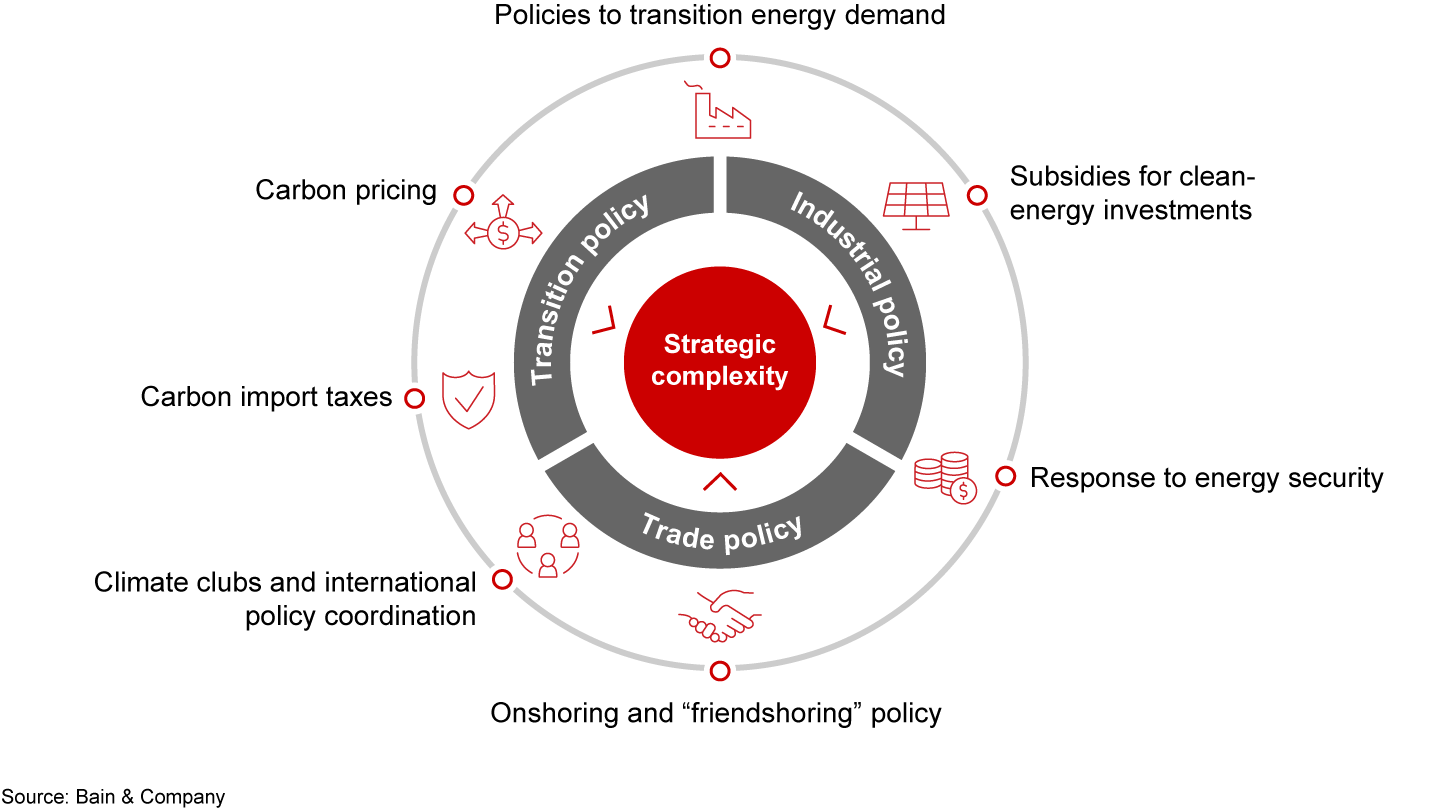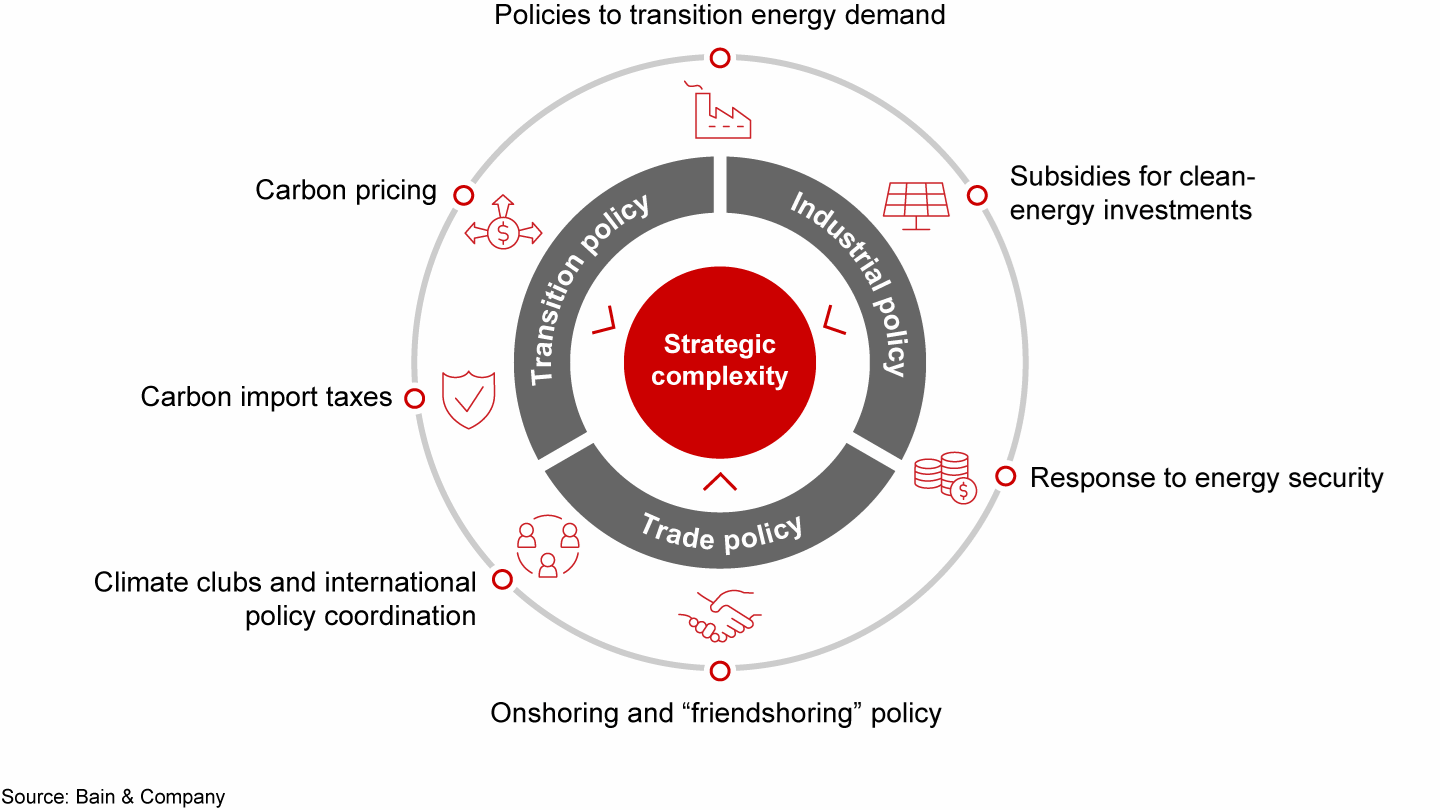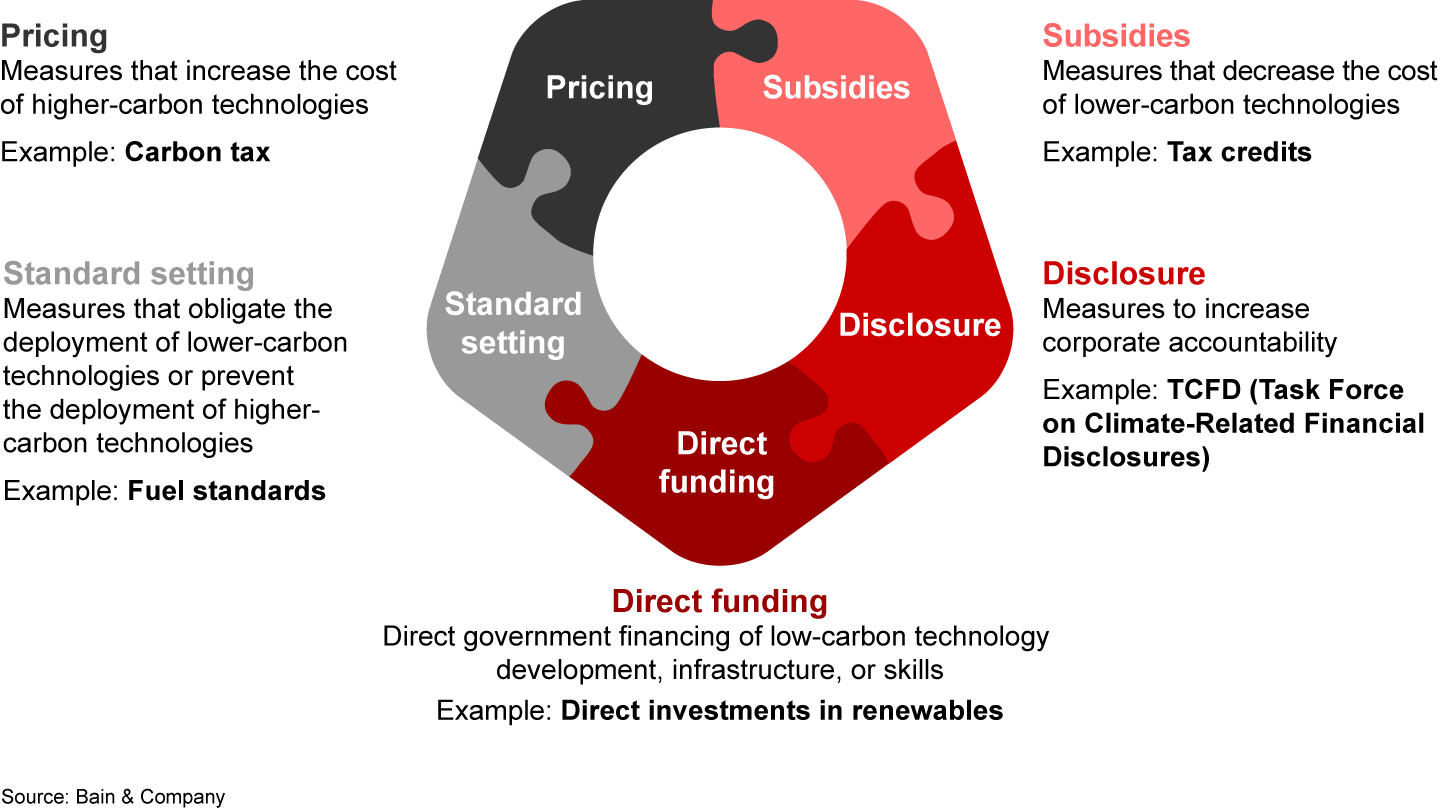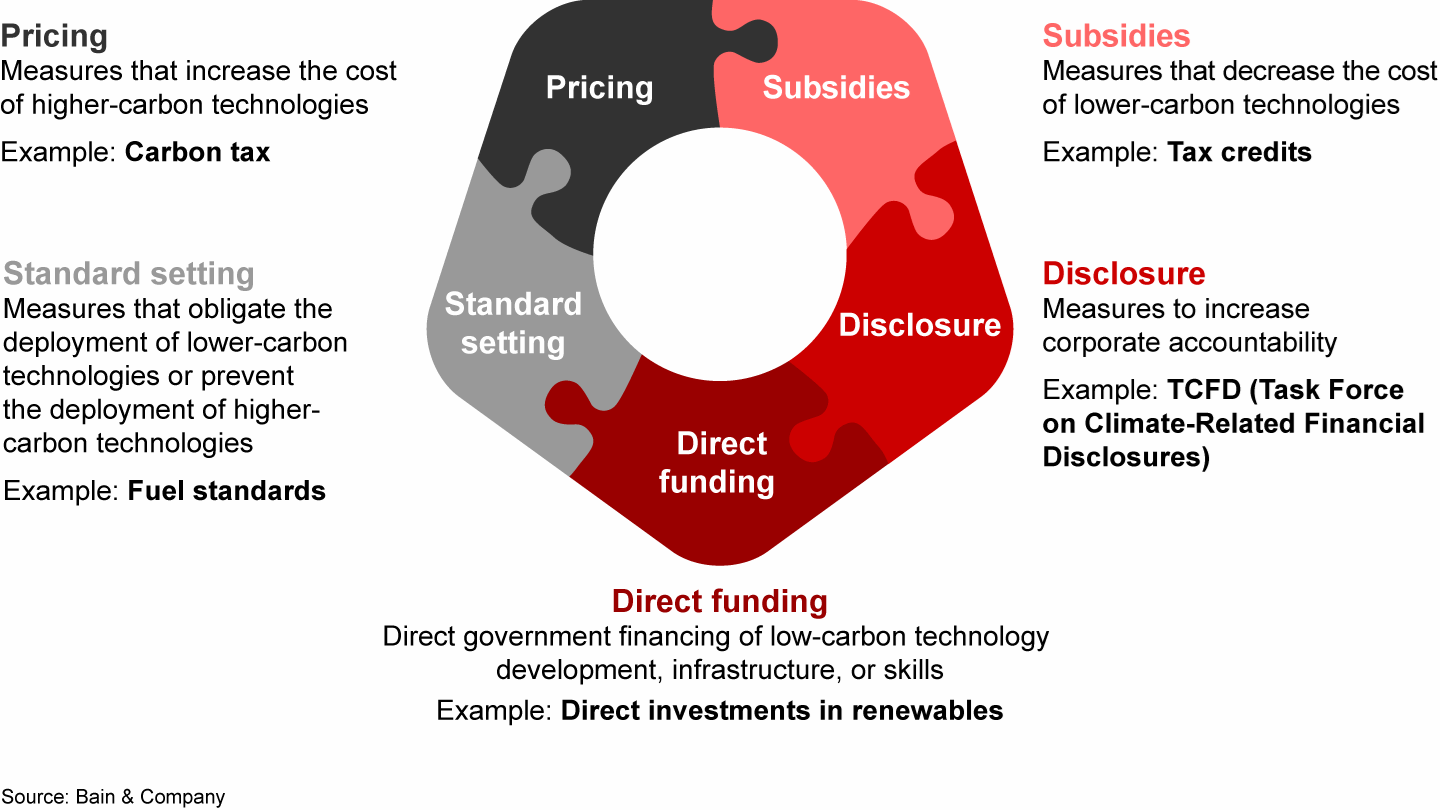The Visionary CEO’s Guide to Sustainability

At a Glance
- The ability to influence policy—and, in turn, customer choices and supply chain dynamics—will be one of the differentiating corporate capabilities of the energy transition.
- Three policy scenarios illustrate how governments will reshape market dynamics over the coming decade.
This article is part of Bain’s 2023 CEO Sustainability Guide
As humanity—with a still-growing population and appetite for energy—tests the limits of our planetary boundaries, the pressure on governments to act is intensifying.
Progress has been made in the transition away from fossil fuels over the past two decades. Clean technologies are taking off across many parts of the global economy. Solar sets new records for deployment each year, with renewables projected by the International Energy Agency to account for 90% of new electricity generation capacity globally between 2022 and 2027. Electric vehicle sales reach new highs each year, and heat pumps are on an exponential growth curve in many markets. Meanwhile, climate commitments from countries and companies have proliferated, reinforcing the political consensus around achieving the Paris goals. Some 90% of global GDP is now covered by net-zero targets.
The policy imperative
Still, the world is a long way from a 1.5-degree future: Clean energy is growing, but so is fossil fuel consumption. To reach net zero by midcentury, it won’t be enough just to keep adding to the supply of renewable energy. Achieving net zero requires the total transformation of the energy system that underpins our economies—including the transition of the 80% of energy demand that is not currently electrified.
But while we have seen how fast the transition can go when the interests of business and government align, economic incentives and the long-term interest of humanity in a stable climate are often in conflict. Publicly listed companies representing about one-third of the global economy have set or committed to science-based climate targets. Few will meet them, absent wider changes in the market environment.
Take, for example, a hypothetical large consumer goods retailer. It could meet its 2030 goals incrementally by adopting sustainable packaging, optimizing supply chains, and investing in energy-efficient processes. But, when the chief sustainability officer looks further out, the transition feels beyond the company’s control; its ability to meet those climate commitments will depend on the availability of low-carbon freight services and manufacturing technologies, not to mention the building, heat, and power sectors.
For many companies, the path to net zero exists in theory but not in practice. Solutions to transition shipping, aviation, and steel are well understood. But deploying them at scale depends on bunkering infrastructure and low-carbon vessels, the scaling of hydrogen or synthetic fuel technologies, and the replacement or retrofitting of steel plants. In all of these cases, the transition will likely involve replacing economically efficient technologies with less efficient ones, making the business case all the harder for competitive industries in globally integrated markets.
We have a term for when economic incentives do not price in damaging outcomes for society, such as extreme climate change: It’s called market failure. But despite the systemic nature of the transition challenge, the pressure at the enterprise level is intensifying. Many investor groups, consumers, and governments are demanding transparency, ambitious targets, and tangible actions toward carbon reduction. Those in the highest-emitting sectors, and particularly the energy sector, can feel this pressure most acutely. Executives from a variety of industries have begun to call for more government intervention.
Clean technologies only scale up when they make money. It is the generation of free cash flows that creates the potential for a virtuous circle of reinvestment. In contrast, managers that commit to driving the transition in opposition to commercial realities risk eroding company value. Pouring money into a low-carbon production capacity with no pathway to profitability is not a solid strategy for scaling low-carbon solutions.
Acknowledging market failure doesn’t mean giving up. Society needs business leaders to take risks, drive innovation, and transform their industries. But in the case of climate, governments also need them to get much louder and more precise about what’s necessary for individual sectors to accelerate the transition. The rewiring of our energy system will only be possible with more rapid scaling of clean technology adoption across both energy demand and supply sectors. All of that will require policy.
Upskilling on policy
As the physical, political, and economic impacts of global warming become more real, government intervention is likely to become bolder and more wide ranging. Done right, these actions will accelerate development and diffusion of clean-energy technologies across all sectors of the global economy—as, in some instances, the invisible hand of the market is being replaced by the strong arm of the state.
This inevitable policy response will play out in different ways in different places, shaped by the political systems and national interests of the major powers.
- In China, a strong state system will provide significant direct support for strategic national industries, incentivizing and enabling the rapid development and deployment of clean-energy technologies.
- Fiscal incentives from the world’s lender of last resort—in the form of tax breaks for clean technologies and jobs—have created a magnetic pull for green capital toward US industries.
- European policy is also shifting. For two decades, the continent drove the decoupling of emissions from growth through regulation and pricing. But with the low-hanging fruit picked, no fiscal union, and fragmented politics, the continent faces tough choices—and the level playing field is giving way to increasing national state aid, challenging the integrity of the single market.
Against this backdrop, all companies will need to anticipate disruptive change. Transition policy—driven by climate but increasingly also by security and affordability—is becoming conflated with trade and industrial policy, as governments navigate a more complex foreign policy environment and race to capture technological advantage in a world with constrained resources and supply-side shocks (see Figure 1).


For companies, resisting progress is always a risky strategy. And when it comes to the energy system, the underlying dynamics of transition make change inevitable. Those able to stay ahead of the curve by enabling their customers and suppliers to overcome transition barriers will secure the greatest commercial advantage.
The ability to understand and navigate policy uncertainty will be differentiating. Policy-driven markets will bring exceptional margins for those with foresight, as other market participants fail to anticipate new sources of green demand. Policy will facilitate or impede global supply chains. And there will be stranded assets and capabilities when regulations outpace expectations.
There are five types of policies that corporations will need to engage on (see Figure 2).


Three policy scenarios
In service of transition trade and industrial policy objectives, governments are already intervening in ways that will disrupt many sectors, as these three examples illustrate.
Thriving in a world in which policy is decisive
All companies will need to navigate this transition. Those that lead will operate with vision, purpose, and pragmatism. Not only will they manage uncertainties, ensuring that their business strategy is credible under a range of policy scenarios, but they will harness the new opportunities presented by policy.
Those that truly thrive will not just react.
They will understand how policy is influencing the dynamics of innovation and technology to transform their industry.
They will anticipate how markets are being shaped, created, and destroyed by governments and invest in new, low-carbon business models and supply chains ahead of demand.
They will work with governments to leverage industrial strategy to overcome transition barriers as they invest in early-stage technology.
They will capture exceptional margins by getting ahead of policy-driven sources of demand, then enjoy a cost advantage as technology diffuses through global markets.
And their corporate affairs teams will be deeply expert in the critical geographies and sectors in which future value is created, building alliances across value chains and influencing the rules of the game.
This ability to influence policy, and therefore customer choices and supply chain dynamics, will be one of the truly differentiating capabilities during the transition to a net-zero energy system. Because in a world in which policy is decisive, management teams that proactively shape their market environment’s policy and stakeholder landscape will not only build stronger businesses that are better able to manage risks; they will also help push forward the changes our global economy requires.